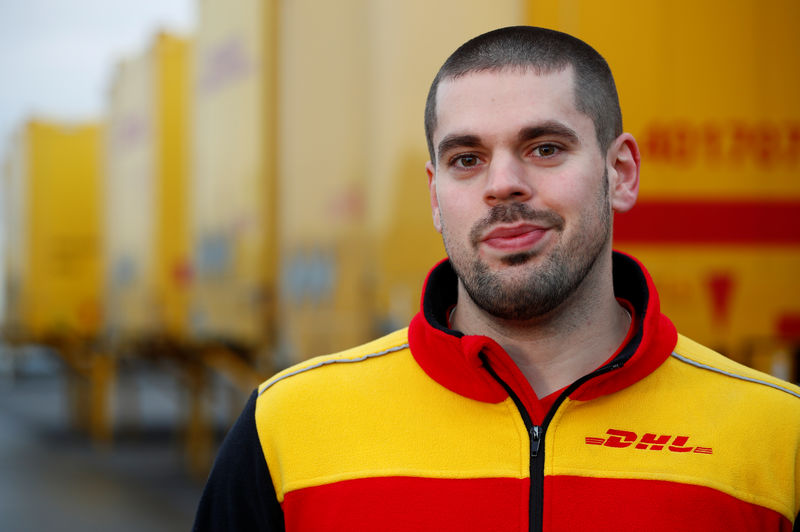By Emma Thomasson
SEHLEM, Germany (Reuters) - Faced with a chronic shortage of truck drivers, logistics firm Deutsche Post DHL Group (DE:DPWGn) is trialing a new scheme to get more people behind the wheel so it can keep goods flowing across Europe, especially at peak times like Christmas.
A lack of drivers is already causing delays and rising costs for businesses in North America and Europe, with consumer goods firm Henkel (DE:HNKG_p) and retailers like Walmart (N:WMT), Kohl's Corp (N:KSS) and TJX (N:TJX) all reporting problems.
DHL Freight is trying to make the job more attractive by offering drivers well-paid contracts, long-term career prospects, more varied work and schedules that allow them to get home to their families in the evening.
"I don't just drive, I also work regularly in the warehouse, doing stock duties, which makes it more varied," said Patrick Klankert, a 27-year-old, who is one of 30 drivers DHL has hired under the pilot scheme.
High staff and transport costs forced the German postal and logistics group to issue a profit warning in June and launch a restructuring program at its Post - eCommerce - Parcel (PeP) division, which employs 184,000 staff.
Walmart, which has seen its profit margins dented by higher freight costs, said in September it plans to double its spending on attracting and retaining drivers for its U.S. fleet of 6,500 trucks, including offering referral bonuses of up to $1,500.
Self-driving trucks could ease the situation but it is unclear how fast that will happen, leading the International Transport Forum think tank to predict a shortfall of up to 800,000 drivers by 2030 in the United States and Europe.
And the prospect of the rise of autonomous trucks is not helping the industry to recruit a new generation of drivers.
"WHOLE SYSTEM FAILS IF TRUCKS ARE LATE"
While DHL's post and parcel division employs its own delivery staff and pays them according to collective wage deals, the freight and forwarding unit operates an "asset-light" strategy based on brokering services from third parties.
DHL Freight's reliance on subcontractors has led to problems in peak seasons when drivers have failed to turn up for shifts, causing knock-on effects for the entire supply chain.
"That's the backbone. If one of the trucks comes in late, the whole system fails," said Tim Scharwath, global chief executive of DHL's global forwarding business for air, ocean and overland freight.
The dearth of drivers has been exacerbated in DHL's home market of Germany by the ending of compulsory military service in 2011, as the army used to train many future truckers.
There were 195,000 open positions in the German logistics industry in the third quarter, up 19 percent on last year, with a particular demand for drivers of trucks and fork-lifts, according to a survey by private training provider WBS Gruppe.
"At Christmas time, the warehouse and logistics industry is booming and more jobs are being advertised than for a long time," said WBS Gruppe head Joachim Giese.
The market is so tight that rivals try to poach DHL staff outside warehouses and while they are making deliveries, said Katja Busch, Deutsche Post DHL's chief commercial officer.
Thorsten Riemenschnitter, who runs a DHL warehouse in the western German village of Sehlem near the Luxembourg border, said finding drivers has been made harder by the country's aging population and low unemployment.
He said potential drivers are also put off by the fact it costs up to 6,000 euros ($6,827) to get a truck license.
SATISFIED AND MOTIVATED
DHL has run an advertising campaign to try to attract candidates for the driver scheme and plans to create up to 500 new jobs across Europe if a pilot is successful.
The new drivers are covered by collective agreements that pay well above the German minimum wage of 8.84 euros an hour and mostly only have to drive in a radius of about 100 km from the warehouse so they can get back home in the evenings.
DHL hopes to lure people from other sectors, like bus drivers, and some women if possible, although Riemenschnitter admits he has only hired men for the scheme so far.
DHL Freight, which currently mostly relies on trucks that are owned by subcontractors, will also order state-of-the-art vehicles for the new drivers, which will include a turning assistant and solar-powered liftgates.
"High quality and customer satisfaction can only be achieved with satisfied and motivated employees - which is why we are actively committed to the profession of truck driver," said Uwe Brinks, DHL Freight chief executive.
"They represent us to our customers every day."
